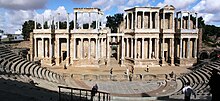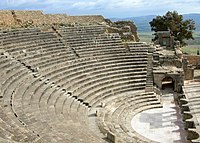Roman theatre (structure): Difference between revisions
No edit summary |
|||
| Line 24: | Line 24: | ||
Roman theatres were built in all areas of the [[Roman Empire|empire]] from medieval-day Spain, to the Middle East. Because of the Romans' ability to influence local architecture, we see numerous theatres around the world with uniquely Roman attributes.<ref name="Jones">Mark Wilson Jones. ''Principles of Roman Architecture.'' New Haven: Yale University Press, 2000.</ref> |
Roman theatres were built in all areas of the [[Roman Empire|empire]] from medieval-day Spain, to the Middle East. Because of the Romans' ability to influence local architecture, we see numerous theatres around the world with uniquely Roman attributes.<ref name="Jones">Mark Wilson Jones. ''Principles of Roman Architecture.'' New Haven: Yale University Press, 2000.</ref> |
||
There exist similarities between the theatres and [[amphitheatre]]s of ancient Rome/Italy. They were constructed out of the |
There exist similarities between the theatres and [[amphitheatre]]s of ancient Rome/Italy. They were constructed out of the diffrent material, Roman concrete,provided a place for the public to go and see numerous events throughout the Empire. However, they are two entirely different structures, with specific layouts that lend to the different events they held. Amphitheatres did not need superior acoustics, unlike those provided by the structure of a Roman theatre. While amphitheatres would feature races and [[gladiator|gladiatorial events]], theatres hosted events such as plays, pantomimes, choral events, and orations. Their design, with its semicircular form, enhances the natural acoustics, unlike Roman amphitheatres constructed [[theatre in the round|in the round]].<ref name="Jones"/> |
||
These buildings were semi-circular and possessed certain inherent architectural structures, with minor differences depending on the region in which they were constructed. The ''[[scaenae frons]]'' was a high back wall of the stage floor, supported by columns. The ''[[Proscenium|proscaenium]]'' was a wall that supported the front edge of the stage with ornately decorated niches off to the sides. The Hellenistic influence is seen through the use of the ''[[proscenium|proscaenium]]''. The Roman theatre also had a ''[[podium]]'', which sometimes supported the columns of the ''scaenae frons''. The ''scaenae'' was originally not part of the building itself, constructed only to provide sufficient background for the actors. Eventually, it became a part of the edifice itself, made out of concrete. The theatre itself was divided into the stage ([[orchestra]]) and the seating section ([[auditorium]]). ''[[Vomitorium|Vomitoria]]'' or entrances and exits were made available to the audience.<ref>K. E. Ros. [http://aal20.tutor.com/nGEN/Apps/SocWeb/main.aspx?ID=31f861c5-766a-45e7-9439-b8f088310911%20 "The Roman theater at Carthage (the theater's substructures, plan and the identification of architectural elements)".] American Journal of Archaeology v. 100 (July 1996) p. 449-89.</ref> |
These buildings were semi-circular and possessed certain inherent architectural structures, with minor differences depending on the region in which they were constructed. The ''[[scaenae frons]]'' was a high back wall of the stage floor, supported by columns. The ''[[Proscenium|proscaenium]]'' was a wall that supported the front edge of the stage with ornately decorated niches off to the sides. The Hellenistic influence is seen through the use of the ''[[proscenium|proscaenium]]''. The Roman theatre also had a ''[[podium]]'', which sometimes supported the columns of the ''scaenae frons''. The ''scaenae'' was originally not part of the building itself, constructed only to provide sufficient background for the actors. Eventually, it became a part of the edifice itself, made out of concrete. The theatre itself was divided into the stage ([[orchestra]]) and the seating section ([[auditorium]]). ''[[Vomitorium|Vomitoria]]'' or entrances and exits were made available to the audience.<ref>K. E. Ros. [http://aal20.tutor.com/nGEN/Apps/SocWeb/main.aspx?ID=31f861c5-766a-45e7-9439-b8f088310911%20 "The Roman theater at Carthage (the theater's substructures, plan and the identification of architectural elements)".] American Journal of Archaeology v. 100 (July 1996) p. 449-89.</ref> |
||
Revision as of 15:21, 18 December 2013
 | |
| Ancient Rome |
|---|
The characteristics of Roman theatres to those of earlier Greek theatres are due in large part to the influence of Ancient Greece on the Roman triumvir Pompey. Indeed, much of the architectural influence on the Romans came from the Greeks, and theatre structural design was no different from other buildings. However, Roman theatres have specific differences, such as being built upon their own foundations instead of earthen works or a hillside and being completely enclosed on all sides. Roman theatres derive their basic design from the Theatre of Pompey, the first permanent Roman theatre.
Structure
Roman theatres were built in all areas of the empire from medieval-day Spain, to the Middle East. Because of the Romans' ability to influence local architecture, we see numerous theatres around the world with uniquely Roman attributes.[1]
There exist similarities between the theatres and amphitheatres of ancient Rome/Italy. They were constructed out of the diffrent material, Roman concrete,provided a place for the public to go and see numerous events throughout the Empire. However, they are two entirely different structures, with specific layouts that lend to the different events they held. Amphitheatres did not need superior acoustics, unlike those provided by the structure of a Roman theatre. While amphitheatres would feature races and gladiatorial events, theatres hosted events such as plays, pantomimes, choral events, and orations. Their design, with its semicircular form, enhances the natural acoustics, unlike Roman amphitheatres constructed in the round.[1]
These buildings were semi-circular and possessed certain inherent architectural structures, with minor differences depending on the region in which they were constructed. The scaenae frons was a high back wall of the stage floor, supported by columns. The proscaenium was a wall that supported the front edge of the stage with ornately decorated niches off to the sides. The Hellenistic influence is seen through the use of the proscaenium. The Roman theatre also had a podium, which sometimes supported the columns of the scaenae frons. The scaenae was originally not part of the building itself, constructed only to provide sufficient background for the actors. Eventually, it became a part of the edifice itself, made out of concrete. The theatre itself was divided into the stage (orchestra) and the seating section (auditorium). Vomitoria or entrances and exits were made available to the audience.[2]
The auditorium, the area in which people gathered, was sometimes constructed on a small hill or slope in which stacked seating could be easily made in the tradition of the Greek Theatres. The central part of the auditorium was hollowed out of a hill or slope, while the outer radian seats required structural support and solid retaining walls. This was of course not always the case as Romans tended to build their theatres regardless of the availability of hillsides. All theatres built within the city of Rome were completely man-made without the use of earthworks. The auditorium was not roofed; rather, awnings (vela) could be pulled overhead to provide shelter from rain or sunlight.[3]

Some Roman theatres, constructed of wood, were torn down after the festival for which they were erected concluded. This practice was due to a moratorium on permanent theatre structures that lasted until 55 BC when the Theatre of Pompey was built with the addition of a temple to avoid the law. Some Roman theatres show signs of never having been completed in the first place.[4]
Inside Rome, few theatres have survived the centuries following their construction, providing little evidence about the specific theatres. Arausio, the theatre in modern-day Orange, France, is a good example of a classic Roman theatre, with an indented scaenae frons, reminiscent of Western Roman theatre designs, however missing the more ornamental structure. The Arausio is still standing today and, with its amazing structural acoustics and having had its seating reconstructed, can be seen to be a marvel of Roman architecture.[3]
List of Roman theatres by modern-day country
This list is non-exhaustive. Links are to mentions of specific theaters. Locations of theaters without further theater information at the location site are mentioned but are not linked.

Bulgaria
- The Plovdiv (ancient Philipoppolis) Roman theatre, still used.
- Sofia (ancient Serdica)
- Stara Zagora (ancient Augusta Trajana), still used.
Croatia
- Pula
Egypt
- Alexandria Roman theatre
France

- Arles - listed as a UNESCO World Heritage Site, together with other Roman buildings of the city
- Autun
- Lyon: ancient theatre of Fourvière
- Lillebonne in Normandy
- Orange, the Théâtre Antique d'Orange is listed as a UNESCO World Heritage Site, together with other Roman buildings of the city
- Vienne, Isère
Germany
- Mainz, Theatrum Mogontiacensium
Italy

- Aosta
- Benevento
- Fiesole
- Cividate Camuno
- Brescia - listed as a UNESCO World Heritage Site, together with other buildings of the city
- Falerone
- Ferento
- Florence (foundings remain)
- Milan (foundings remain)
- Pompeii
- Theatre of Marcellus, in Rome
- Theatre of Pompey, in Rome
- Ostia Antica
- Suasa
- Spoleto
- Taormina, Sicily (Greek theatre)
- Teramo
- Trieste
- Turin (foundings remain)
- Urbisaglia
- Verona
Israel
- Caesarea Maritima
- Scythopolis (Beit Shean)
- Eleutheropolis (Beit Guvrin)
- Sebaste (Samaria)
- Neapolis (Nablus)
- Hamat Gader
- Sepphoris (Tzippori)
- Tiberias
- Hippos
- Shuni (Binyamina)
Jordan

- Philadelphia (Amman)
- Abila (Decapolis)|Abila
- Gadara (2)
- Gerasa (2)
- Pella, Jordan|Pella
- Petra
Libya
- Leptis Magna
- Sabratha
Luxembourg
- Dalheim Ricciacum
Republic of Macedonia
Portugal
- Lisbon (wikimapia)
Spain

- Theatre of Acinipo
- Theatre of Baelo Claudia
- Theatre of Baetulo
- Theatre of Caesar Augusta (Zaragosa)
- Theatre of Carthago Nova (Cartagena)
- Theatre of Clunia Sulpicia
- Theatre of Corduba (Córdoba)
- Theatre of Emerita Augusta (Mérida)
- Theatre of Gades (Cádiz)
- Theatre of Italica
- Theatre of Malaca (Málaga)
- Theatre of Medellín
- Theatre of Pollentia (Mallorca/Alcudia)
- Theatre of Sagunto
- Theatre of Segobriga
- Theatre of Tarraco
Switzerland

- Augusta Raurica
- Aventicum
- Lenzburg
Syria

- Roman Theatre at Apamea
- Roman Theatre at Bosra
- Dura-Europos (wikimapia, wikimapia, reference)
- Roman Theatre at Palmyra
- Shahba
- Jableh
Tunisia


Turkey
- Ancyra
- Aphrodisias (pre-Roman origins)
- Arycanda
- Aspendos
- Caunus
- Ephesus
- Erythrai
- Euramos
- Halicarnassus
- Hierapolis
- Knidos (wikimapia, pre-Roman origins)
- Laodicea on the Lycus
- Miletus
- Myra
- Nysa
- Patara
- Pergamon
- Perge
- Phaselis
- Phocaea
- Sagalassos (wikimapia, pre-Roman origins?)
- Selge
- Side
- Telmessos
- Termessos (wikimapia, pre-Roman origins)
- Vize
United Kingdom
- Camulodunum (modern day Colchester)[5]
- Verulamium (modern day St Albans)[6]
See also
References
- ^ a b Mark Wilson Jones. Principles of Roman Architecture. New Haven: Yale University Press, 2000.
- ^ K. E. Ros. "The Roman theater at Carthage (the theater's substructures, plan and the identification of architectural elements)". American Journal of Archaeology v. 100 (July 1996) p. 449-89.
- ^ a b Richard Allan Tomlinson. "Theatres (Greek and Roman), structure", The Oxford Companion to Classical Civilization. Ed. Simon Hornblower and Antony Spawforth. Oxford University Press, 1998. Oxford Reference Online. Oxford University Press. Northwestern University. 11 May 2007.
- ^ Constance Campbell. "The Uncompleted Theatres of Rome", The Johns Hopkins University Press. Theatre Journal 55.1 (2003) 67-79 10 May 2007.
- ^ [1] (Colchester Museums official website).
- ^ Roman Theatre of Verulamium (official website).


